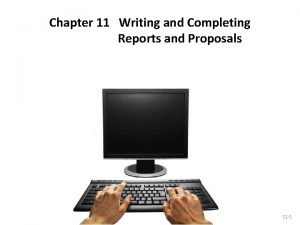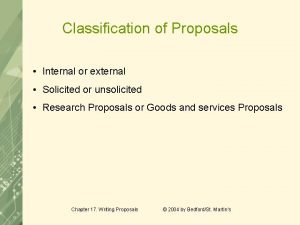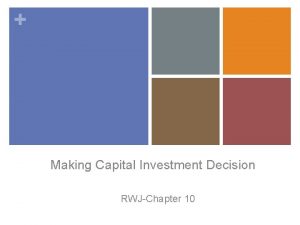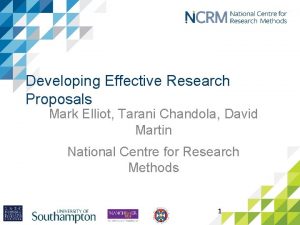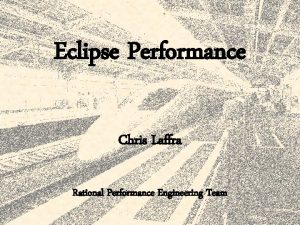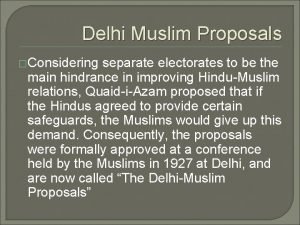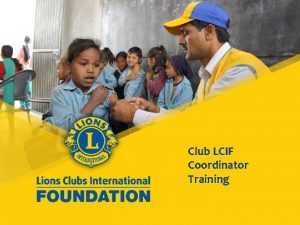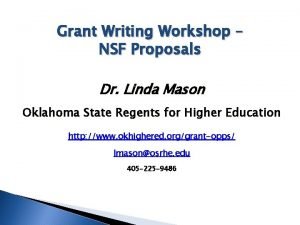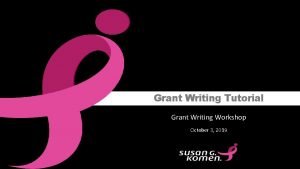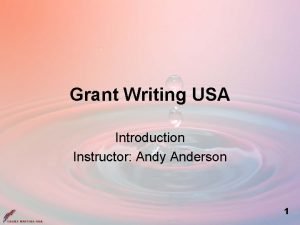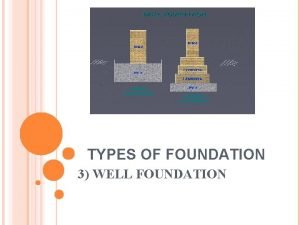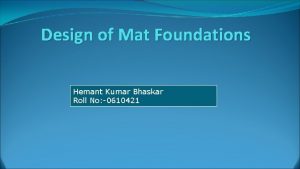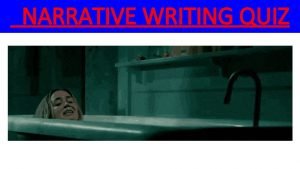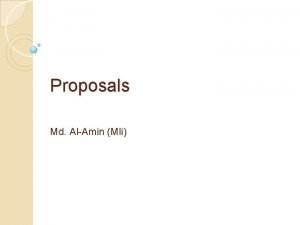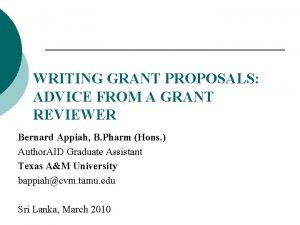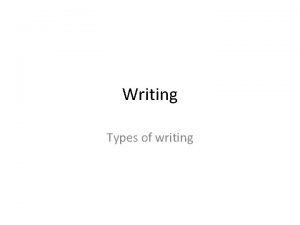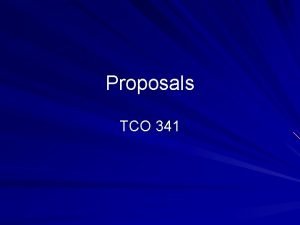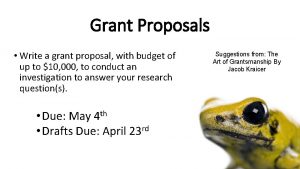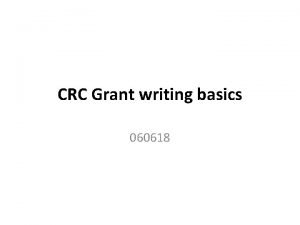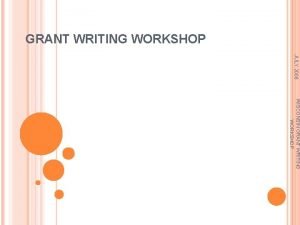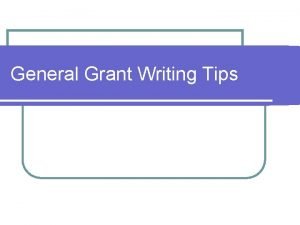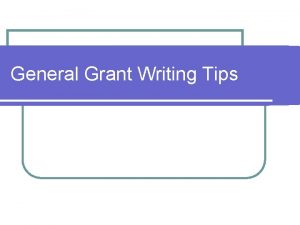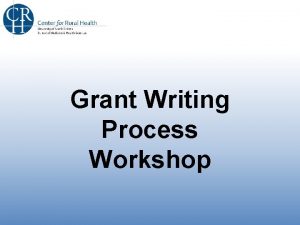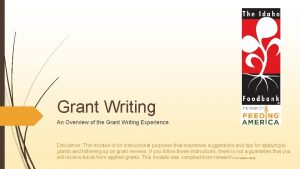Writing Foundation Grant Proposals Two types of grant




















- Slides: 20

Writing Foundation Grant Proposals

Two types of grant sources n Private n Public sources (foundations) sources (government)

Preliminary Steps n Research possibilities n Geographical span n Kind of support n Programs of interest n Possible resources n www. fdncenter. com n Corporate websites/annual reports n Professional magazines

Preliminary Steps (con’t. ) n Organize n Create a list of potential donors that best fit your organization’s goals. n Create a database of each prospects information, type of grant, applications, deadlines, etc.

Foundations are required

Common Types of Foundation Grants n Capital n Supports building renovation/expansion n Endowment n Investment funds that secures future operating n General Operating n Supports daily operations n Program-related n Loans money from its endowment at an affordable interest rate

Common Types of Foundation Grants (con’t. ) n Project grant n Short-term funding of specific programs n Seed funding n Aids start-up organizations or new programs n Technical Assistance n Funding for professional consulting

Federal Grant Considerations n Lengthy proposals n Response time n Guidelines can change abruptly with new legislation n Need to comply with federal regulations before and after receiving the award

Advantages to Federal Grants n Awarded in large amounts n Awarded in multi-year installments n Records of past awards and grant proposals are made public

Basic Approach to Grant Writing in 3 Steps n Introduction of Problem n Improvement n Solution Goals and Methodology

2 Proposal Techniques n Original Idea n Invitation n Response to a disclosure that indicates a pool of funds is available to target a specific need or problem n Program Announcement (foundation) n Requests for Proposals (government)

8 Standard Components of a Grant Proposal Cover letter and Summary Most personal section Provides brief overview of attached proposal Includes any previous contact with the donor Lists contact information

8 Standard Components of a Grant Proposal (con’t. ) 1. Introduction and Background Provides snapshot of organization (history, awards, mission, media reviews, etc. ) 2. Problem Statement/Needs Problem statement used when writer is initiating a new relationship with the targeted persons. Needs assessment when there is a previous relationship between the grant seeker and the constituents. Note: This is not where the solution is referenced!

8 Standard Components of a Grant Proposal (con’t. ) 3. Goals, Objectives, & Outcomes Follow-up the “problem” with the organization’s vision for improvement. Goals: Broad visions of future with help of funding agency. Objectives: Measurable results of future development in problem area (how many affected, how long, etc. ) Outcomes: Addresses the overall goal of the organization by answering questions about the importance of supporting the program/project.

8 Standard Components of a Grant Proposal (con’t. ) 4. Methods Introduces the ideas for tackling the issue Must keep the reader interested Begin with overview of strategy followed by the project in detail Includes the plan of action Hiring of additional staff Marketing tools Project timelines Justifiable methods

8 Standard Components of a Grant Proposal (con’t. ) 5. Evaluation n n How the success of program will be measured in terms of meeting goals, objectives, and outcomes Indicate the specific tools and methods used to gather information and analyze the program

8 Standard Components of a Grant Proposal (con’t. ) 6. Budget Needs to be concise and believable 7. Future Funding Explain the project’s sustainability Identify other grant or funding sources Note: You can ask for funding even if you have asked for funding elsewhere. Potential sources of future funding Earned revenue (membership) Government contracts Donor campaigns

8 Standard Components of a Grant Proposal (con’t. ) 8. Conclusion Avoid restating the proposal summary Include an appendix 4 standard components Non profit status document Board of Directors Annual Budget Previous financial statements Other possible additions Marketing materials Organizational chart Past donors Media coverage

Writing a Proposal Letter n Contains 8 standard elements, but in brief! n Strong emphasis on the organization’s management when submitted to a corporate foundation

8 Standard Components 1. Introduction/Background 2. Problem Statement/Needs Assessment 3. Goals, Objectives, & Outcomes 4. Methods 5. Evaluation 6. Budget 7. Future Funding 8. Conclusion
 Title of the study
Title of the study Writing and completing reports and proposals
Writing and completing reports and proposals Prefatory elements in proposal exclude
Prefatory elements in proposal exclude What are the two categories of external proposals
What are the two categories of external proposals Formal business report
Formal business report Artificial intelligence thesis proposals
Artificial intelligence thesis proposals Nature and use of fire insurance
Nature and use of fire insurance Capital investment decision
Capital investment decision Developing effective research proposals
Developing effective research proposals Eclipse computing proposals slow
Eclipse computing proposals slow Delhi muslim proposals
Delhi muslim proposals Lcif grant application form
Lcif grant application form Amber foundation grant
Amber foundation grant Pile foundation details
Pile foundation details Composition of urine
Composition of urine Grant writing examples
Grant writing examples Grant writing tutorial
Grant writing tutorial Grant writing usa
Grant writing usa Types of caissons
Types of caissons Mat foundation design
Mat foundation design Narrative essay quiz
Narrative essay quiz

